mobile View, to the German Version tap the flag


- 1556–1804
- Empire of the Austrian Habsburgs
• Flags
• Meaning/Origin of the Flag
• Coat of Arms
• Meaning/Origin of the Coat of Arms
Further Austria pages (historical Flags and Coats of Arms):
• Empire of Austria (1814–1867)
• Austria-Hungary (1867–1918)
• Republic of Austria (since 1918)
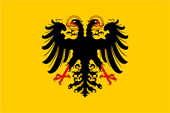
1686–1836,
Flag of the monach,
reconstruction,
Source, by: austria-forum.org



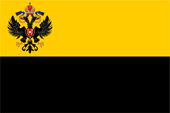
1716,
Naval and war flag,
ratio = 2:3,
Source, by: Arthur von Khuepach, Marine-Rundschau, Nr. 46, Mönch, Bonn, 1941, via:
zeljko-heimer-fame.from.hr



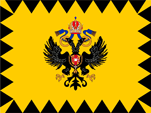
1730,
Naval and war flag,
ratio = 3:4,
Source, by: austria-forum.org




1730–1749,
Merchant flag,
Source, by: Josef von Lehnert, Organ der mil.-wiss. Vereine, Nr. 31, Wien
1886, Lothar Baumgartner, Wien, 1977, via:
zeljko-heimer-fame.from.hr



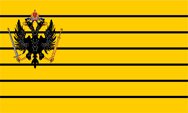
1749–1786,
Merchant flag,
ratio = 3:5,
Source, by: austria-forum.org



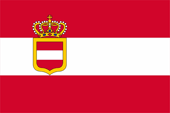
1786–1804,
Offshore flag (merchant and naval flag),
Source, by: austria-forum.org,
zeljko-heimer-fame.from.hr





The flags used in the Habsburg's domain often showed the colors black and gold and a double-headed eagle. These are the colors of the German Empire (actually the Holy Roman Empire of German Nation), whose emperor came out of the dynasty of the Habsburgs from 1438 to 1806. The coat of arms of the empire showed from 1433 a black, double-headed eagle on gold, from which the colors are derived. Thus the eagle is the symbol of the empire, even if it is nowadays sometimes called "Habsburg Eagle". The Habsburgs heraldry is actually different. Originally a red, blue armored lion on gold. The Austrian band-shield, which originally came from the Babenberg dynasty was added later, to clearly identify the Habsburgs as the "House of Austria". The marriage of Maria Theresia and Franz Stephan von Lothringen in 1736 created the line of Habsburg-Lorraine.
The German Empire, which existed until 1806, was an electoral monarchy, so the dignity of the emperor was not hereditary. Nevertheless, out of the House of Habsburg the German emperors came for centuries. The heraldry of the German Empire and the colors black and gold were transferred to the House of Habsburg, so that flags in these colors were used throughout their domain. It is important to note that the heraldry and colors passed from the German Empire to the House of Habsburg and not vice versa. For the monarch's personal flag, this means that it must have been the flag of the empire. A "Habsburg Empire" was not defined. There was only the elected Emperor of the German Empire from the House of Habsburg with his own property, in form of his own inheritance. In this way is the transfer of Habsburg heraldry into symbols of the German Empire not appropriate and unlikely. Nevertheless, dubious images of the imperial eagle with the Habsburg house-crown above them can be found as symbols of the German Empire. Flags in the original have not survived from this time, only vague descriptions that can be incorrect. For some hereditary lands, what means the direct domain of the Habsburgs, this phenomenon occurs. In 1686, for example, the golden flag with the two-headed eagle was officially introduced as the flag for the Habsburg domain. This was also maintained when the German Empire went under in 1806 and Austria (already in 1804) had been defined as a separate state. Even when a new German Empire was founded in 1871, which at least used a black eagle on gold in the coat of arms.
The the eagle-flag was allowed to use the flag by private persons in the sense of a merchant flag until 1749. But that flag was difficultly to produce and thats why arised already about 1730 flags with two stripes in the colours black and gold. In this way became the device of the black eagle on golden ground abridged heraldical: black over gold. Since the establishment of the Empire of Austria in 1804 it was allowed to use this flag as national flag.
In 1749 it was officially introduced a merchant flag. It showed narrow black stripes on a golden background and the double-eagle the top corner. Its appearance is said to have been adapted to the flag of Tuscany, then dominated by the Habsburgs, in order to also come under the protection of an agreement with pirated barbaresques.
For the Navy a new flag was introduced in 1730. It was single coloured golden with a border of black triangles, and showed the Austrian double-eagle in the center. It was probably used until the beginning of the 19th century. There has been also simplified versions in which only a narrow black border was placed around the field with the eagle.
Emperor Joseph II then broke with the black and gold continuity and on 20th of March in 1786 he introduced the first truly Austrian flag for use at sea. It showed the picture of the Austrian band-shield, three horizontal stripes in red, white and red and in the middle, shifted towards the mast, the golden banded band-shield with a stylized royal crown above it. The colors black and gold were increasingly reserved for the state and its representatives.
Source:
austria-forum.org,
zeljko-heimer-fame.from.hr,
Volker Preuß


since 1736,
Coat of arms of the line of Habsburg-Lorraine,
Source, by: Wikipedia (D)

The eagle coat of arms

The House of Habsburg divided in 1556 in a Spanish and in an Austrian line. Both lines used the black double-headed eagle of the Holy Roman Empire of German Nation (Old German Empire, First Empire) for centuries. The Habsburgs heraldry is actually different. Originally a red, blue armored lion on gold. The Austrian band-shield, which originally came from the Babenberg dynasty was added later, to clearly identify the Habsburgs as the "House of Austria". The marriage of Maria Theresia and Franz Stephan von Lothringen in 1736 created the line of Habsburg-Lorraine. The coat of arms of Lorraine shows a golden shield, topped with a red slant right bar, which is in further topped with three silvery Alerions. The coat of arms of the dynasty of Habsburg-Lorraine – as a combination of the heraldry of Habsburg, Babenberg and Lorraine – was placed on the eagle from time to time when only the Habsburg hereditary lands were to be represented, sometimes only the red-white-red band-shield.
Source: Volker Preuß

look Austria

![]()





















